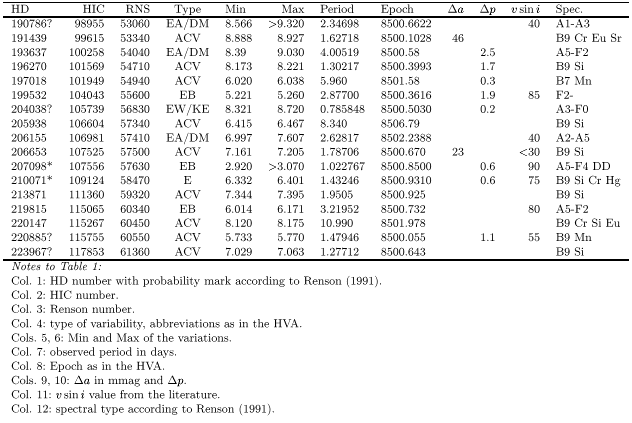Variability of "classical'' Ap stars (= magnetic chemically peculiar
stars of the upper
main sequence) is a common phenomenon. Ludendorff (1906) already reported
line variations in the spectrum of the "prototype'' Ap star ![]() CVn. The (asymmetrical) light curve of this star was first measured
by Guthnick & Prager (1914).
CVn. The (asymmetrical) light curve of this star was first measured
by Guthnick & Prager (1914).
It took almost 50 years to find the physical background for this variability. Babcock (1947) and Stibbs (1950) developed the oblique rotator model for these stars in which their magnetic field is inclined at a certain angle to the rotation axis. The observed variations are therefore coupled with the apparent magnetic field as the star rotates. This theory was highly successful in explaining magnetic field variations together with photometric as well as spectral line variations. It was used to develop the technique of "Doppler-imaging'' (Deutsch 1970) in order to map the abundances of elements on the stellar surface.
The second kind of variability of CP stars is due to binarity causing light variations. All type of eclipsing systems were detected and play an especially important role concerning the Am-Fm phenomenon (Budaj 1997).
We have used the extensive Hipparcos Variability Annex (HVA hereafter) in order to search for peculiar stars included in the catalogue of Ap and Am stars by Renson (1991). 293 stars were found in both catalogues (33 were excluded, see next section), half of these stars had been already known as variable, whereas 130 stars are newly identified variable CP stars (Table 1). Concerning the rotational photometric variability it has to be emphasized that the photometric band operated by Hipparcos is by no means the most suitable to detect this kind of variations: for blue magnetic (CP2) stars the amplitude decreases from the UV towards longer wavelengths, for the cooler CP2 stars the largest variability has been found to occur in the Strömgren v band. On the other hand the large number of Hipparcos measurements appearing in the HVA compensate for this intrinsic disadvantage. This situation naturally calls for future ground based observations at shorter wavelengths both for confirming the periods determined and in order to establish the run of the light curve structure with wavelength.

|

|
Copyright The European Southern Observatory (ESO)